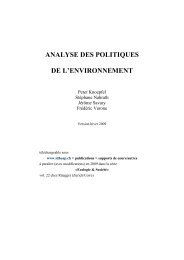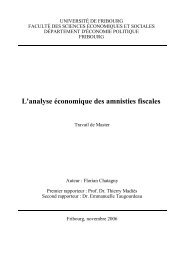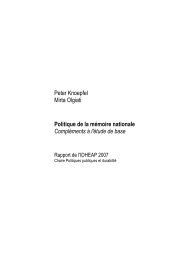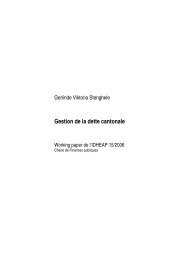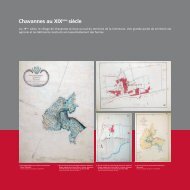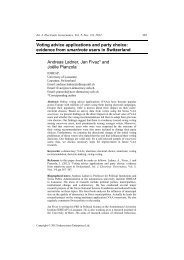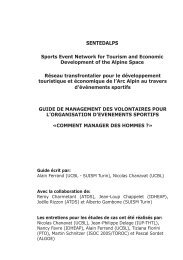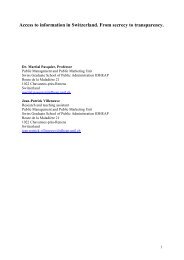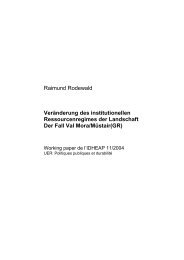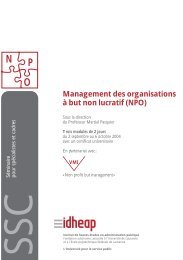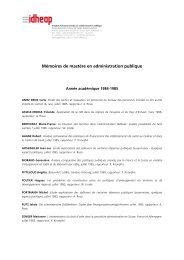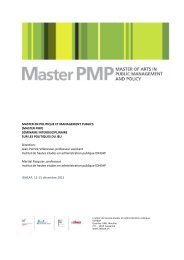Historical Analysis of Institutional Regimes in Switzerland ... - IDHEAP
Historical Analysis of Institutional Regimes in Switzerland ... - IDHEAP
Historical Analysis of Institutional Regimes in Switzerland ... - IDHEAP
You also want an ePaper? Increase the reach of your titles
YUMPU automatically turns print PDFs into web optimized ePapers that Google loves.
12<br />
Property-rights-driven trajectory: With this type <strong>of</strong> development trajectory, property and use rights<br />
are def<strong>in</strong>ed and distributed <strong>in</strong> the absence <strong>of</strong> the conception and implementation <strong>of</strong> policy designs.<br />
Hence, ownership <strong>of</strong> a resource or the goods and services it produces are almost absolute and<br />
unlimited. With this scenario, policy designs which limit the content <strong>of</strong> use and property rights or<br />
distribute them among various owners, appropriators and f<strong>in</strong>al consumers are not developed until a<br />
later stage.<br />
Non-l<strong>in</strong>ear trajectory: It is important to note that exceptions to the three above-described<br />
development trajectories may occur. Some IRs may deviate from the assumed parallelism or clear<br />
priority <strong>in</strong> the historical evolution <strong>of</strong> the degrees <strong>of</strong> differentiation between regulative systems and<br />
policy designs or from the assumed priority <strong>of</strong> one element over the other one. Thus, a highly<br />
differentiated policy design could become radically simplified if legislation <strong>in</strong>troduces a more<br />
sophisticated property and use rights arrangement which is considered as sufficiently guarantee<strong>in</strong>g a<br />
more susta<strong>in</strong>able use <strong>of</strong> threatened naturally produced goods and services (e.g. privatisation <strong>of</strong><br />
previously state-owned resources or the opposite movement towards nationalisation). The same<br />
appears even more likely <strong>in</strong> the case <strong>of</strong> chang<strong>in</strong>g degrees <strong>of</strong> policy design differentiation <strong>in</strong> the<br />
absence <strong>of</strong> a correspond<strong>in</strong>g (explicit) change <strong>of</strong> the regulative system, such as can be observed <strong>in</strong> the<br />
case <strong>of</strong> many clean air policies <strong>in</strong> some European countries over the past decade (e.g. <strong>in</strong>creas<strong>in</strong>gly<br />
differentiated policy designs <strong>in</strong>clud<strong>in</strong>g more and more pollut<strong>in</strong>g substances and ambient air quality<br />
standards without visible changes to the attribution <strong>of</strong> the actual permits among different emitter<br />
groups).<br />
5 Initial Empirical Evidence from <strong>Switzerland</strong>: The Steer<strong>in</strong>g<br />
Potential <strong>of</strong> Exist<strong>in</strong>g <strong>Regimes</strong> and Regime Change<br />
5.1 <strong>Institutional</strong> Resource <strong>Regimes</strong> <strong>in</strong> <strong>Switzerland</strong><br />
The examples from <strong>Switzerland</strong> show a vast spectrum <strong>in</strong> terms <strong>of</strong> IR differentiation. <strong>Analysis</strong> <strong>of</strong> the<br />
legislation revealed that <strong>in</strong> <strong>Switzerland</strong>, formal property and use rights are <strong>of</strong>ten based on federal civil<br />
or (additional) cantonal civil or public law, whilst the public protection and use policies can for the<br />
most part be formally associated with what is known as the federal or cantonal public law. The Swiss<br />
regulative systems have their legal basis <strong>in</strong>ter alia <strong>in</strong> the Swiss Federal Constitution (property<br />
guarantee: Article 26) and the Swiss Civil Code (general def<strong>in</strong>ition <strong>of</strong> property: Article 641).<br />
Moreover, property restrictions are also <strong>in</strong>creas<strong>in</strong>gly regulated <strong>in</strong> the special federal public legislation<br />
and/or the correspond<strong>in</strong>g cantonal <strong>in</strong>troduction acts (e.g. environmental protection, construction and<br />
regional development legislation, general and special police restrictions <strong>of</strong> ownership). F<strong>in</strong>ally, there<br />
are formal and <strong>in</strong>formal rules and regulations <strong>in</strong> the sense <strong>of</strong> common-property, whose significance<br />
should not be underestimated and which render the task <strong>of</strong> classification <strong>in</strong> terms <strong>of</strong> different<br />
property types extremely difficult.<br />
The follow<strong>in</strong>g descriptions <strong>of</strong> IRs are provided as examples <strong>of</strong> particular comb<strong>in</strong>ations <strong>of</strong> regulative<br />
systems and specific protection and use policy designs. Figure 3 shows a graphical presentation <strong>of</strong> its<br />
application to the resources soil, water, forest, air and landscape <strong>in</strong> <strong>Switzerland</strong> at the end <strong>of</strong> the 20 th<br />
century.<br />
Figure 3: The gradual differentiation <strong>of</strong> IRs for five resources <strong>in</strong> <strong>Switzerland</strong>



